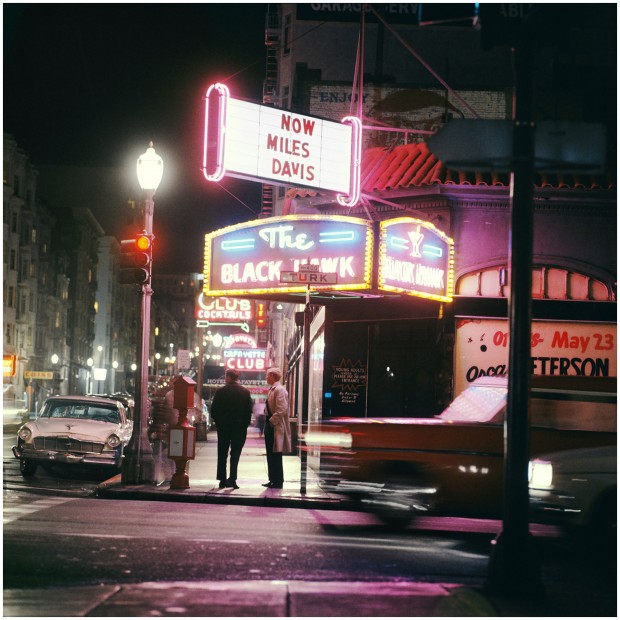An iconographic and text archive related to communication, technology and art.
☛ Morrison Hotel Gallery: “Miles Davis, San Francisco, 1961” color photograph by Leigh Wiener. Used with permission from The Estate of Leigh Wiener. © 1961 Leigh Wiener. All Rights Reserved.
Miles Davis’s two-night stand at The Black Hawk in San Francisco marked a watershed in jazz history, a seminal event transforming the American musical landscape. Davis had never been recorded live in a club with his combo and the performances over the course of two sets a night on April 21 and 22, 1961 more than justify the legend. The New York Times, in its review of the Columbia Records release of the complete Black Hawk shows, called the music “the gold standard for straight-ahead, postwar jazz rhythm.” Leigh Wiener’s shot of the club bathed in the neon and streetlights seductively hints at the promise of the music just behind the door.
The Black Hawk in San Francisco’s Tenderloin district was a legendary nightclub where many great jazz men performed and numerous recordings where made. It was closed in 1963. In the Spring of 2012, a bronze plaque was embedded in the sidewalk to commemorate its historical importance (image retrieved from ArtsAmerica.org)

To learn more about the Black Hawk, read “The Blackhawk Gets Its Due” by long time jazz journalist Doug Ramsey (published on his blog Rifftides which was voted blog of the year in 2010 by the international membership of the Jazz Journalists Association). In his text Ramsey points to a film of jam session by The David Brubeck Quartet recorded inside the Black Hawk. The film is available on YouTube and embedded below as well:
The Morrison Hotel Gallery hosts 11 photos by Leigh Wiener. Wiener’s official website offers a brief but compelling overview of the photographer’s life (which was re-used on multiple websites including the Morrison Hotel Gallery and Craig Krull Gallery):
During his 50-year career as a photographer and photojournalist, Leigh Wiener photographed every U.S. president from Truman to Reagan, Hollywood legends from Marilyn to Marlon, musicians from Miles to Sinatra, poets, scientists, playwrights and industry titans. Born in 1929, Wiener grew up in New York City, where his father worked as a newspaper man. Arthur “Wegee” Felig, a family friend who worked as a freelance news photographer, first taught Wiener to look at pictures. By 15, he had sold a photo to Collier’s. He moved to Los Angeles in 1946, working in the library at the Los Angeles Times. His first big break as a photographer came in 1949, when he photographed the empty swing of Kathy Fiscus. The three-year-old captured the world’s attention when she fell down an empty well, but by the time rescuers found her, she had died. Wiener’s photo ran on the front page of more than 100 papers around the country. Wiener went on to become a staff photographer at the Los Angeles Times and then shot freelance for Life, Time, Fortune – Sports Illustrated and many more. He created and co-hosted the Emmy Award-winning half-hour television show “Talk about Pictures” on KNBC, Channel 4, in Los Angeles and received numerous awards for his football motion picture documentary “A Slice of Sunday.”
There are some discrepancies online about Leigh Wiener year of birth. The New York Times, The Independent and Variety either states that he was born in 1931 or that he died at 62 years old, while Wikipedia and his official website have him born in 1929. In an email exchange, his son generously provided me with the correct information: “Leigh Wiener was born on August 25th 1929. He died on May 11th 1993 at the age of 63 years, 8 months and 16 days old”. To learn more about Leigh Wiener, browse his official website or check one of the following newspaper article: The New York Times: “Leigh Wiener, 62, Photographer Of the Famous and the Historic” by Wolfgang Saxson, May 14, 1993; The Los Angeles Times: “Exhibit Surveys Work Of Photojournalist Wiener” by Herman Wong, September 19, 1996.
Leigh Wiener died in 1993, due to a complicated illness presumably caused by one of his very first assignment:
One of his earliest assignments was to photograph the atomic bomb tests on the Nevada desert flats in 1958. The exposure to radiation he sustained there was the probable cause of the blood disease Sweet’s syndronne, which led to his death. (The Independent: “Obituary: Leigh Wiener” by Peter Ride, May 22, 1993)
• • •
First spotted via Evan Cordes’s Mlkshk. Original source for the hi-res image: Jazz In Photo.
Previously, also from the Morrison Hotel Gallery: Charles Mingus, NYC, 1959, by Don Hunstein
- By Philippe Theophanidis
- on
- ― Published in Art, Music, Photography
- Tagged: Black Hawk, club, color, jazz, Leigh Wiener, Miles Davis, photojournalism

